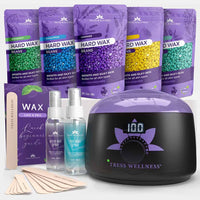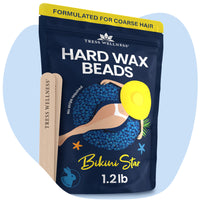Not getting the desired results from home waxing? Getting rashes, burns, and bruises from waxing is not common. And going over the same area again and again means that you are doing something wrong. Waxing mistakes can totally ruin your dreams of achieving smooth skin.
Let’s take a look at the common signs that you are waxing it all wrong:
- Uneven Hair Removal: If you notice patches of hair left behind or uneven removal, it could be a sign of inconsistent wax application or improper technique.
- Excessive Redness: While some redness is normal after waxing, excessive and prolonged redness may indicate irritation, improper wax temperature, or sensitivity.
- Skin Burns or Irritation: Burns or excessive irritation may occur if the wax is too hot or if the same area is waxed multiple times. Proper temperature control and technique are crucial.
- Ingrown Hair: Ingrown hairs can result from improper waxing, such as pulling the hair in the wrong direction or waxing too short hair.
- Bruising or Tearing: Bruising or tearing of the skin may occur if the wax is applied too forcefully or if the skin is stretched improperly during the waxing process.
- Residue Left on the Skin: If there's leftover wax on your skin after the process, it suggests incomplete removal and could lead to skin irritation.
- Excessive Pain: While some discomfort is expected, excessive pain may indicate that the waxing process is too harsh or that the skin is being pulled too forcefully.
- Allergic Reactions: Signs of allergic reactions, such as redness, itching, or swelling, may occur if you're using a wax formula that doesn't agree with your skin.
- Broken or Torn Hair: If the hair is breaking or tearing rather than being pulled from the root, it may suggest that the wax is not adhering properly or that the hair is too short.
Getting it Right! The Signs of a Great Waxing Session
The rewards of a great waxing session are plenty.
In addition to smoother, longer-lasting results for weeks, here are a few things that can indicate that you are on the right track while waxing at home.
- Smooth and Even Hair Removal: The most obvious sign is smooth and even hair removal. If you've effectively removed unwanted hair without leaving patches, you're on the right track.
- Temporary Redness: Some redness is normal, but it should be temporary. A well-waxed area may appear slightly red immediately after, but this should subside within a few hours.
- Minimal Pain or Discomfort: While some discomfort is expected, minimal pain or discomfort during and after the waxing process is a positive sign. It suggests that the waxing technique was gentle and effective.
- Hair Removal from the Root: Successful waxing removes hair from the root, leading to smoother skin for a more extended period. If you notice hair with a bulb at the end, it's a good sign.
- No Bruising or Tearing: There should be no signs of bruising or tearing on the skin. A well-done waxing session is gentle on the skin and minimizes the risk of trauma.
- No Ingrown Hair: Proper waxing technique reduces the likelihood of ingrown hairs. If you don't notice ingrown hairs in the days following the session, it's a positive outcome.
- No Allergic Reactions: If your skin shows no signs of allergic reactions, such as redness, itching, or swelling, it indicates that the wax formula used is suitable for your skin type.
Waxing Mistakes and How to Avoid Them
Waxing adventures should be smooth, not sticky! Let’s walk you through the six common waxing mistakes that might be tripping up your at-home glam sessions. But worry not, because for each oops, we have an aha!
Avoid these six waxing mistakes for flawless, fuzz-free skin!
1. Not patch testing your wax
The number one reason you might be getting bumps, rashes, and infections on your skin from waxing is using the wrong wax for your skin. Before you take up a spatula full of wax to slather all over your body, do a patch test and check whether your skin reacts to it. Some people have sensitive skin and not all kinds of wax suit them. Go for alternatives that are formulated especially for sensitive skin types. But even then, do a patch test before.
2. Moisturizing your skin before waxing
While it is a great practice to keep your skin hydrated and moisturized every day, this is not the case before you are waxing. This is the main reason why your wax might not stick to the hair. Oily skin does not allow the wax to sit well on it. Cleanse your skin thoroughly but do not apply moisturizer on the day of waxing. You could opt for a pre-waxing spray that holds the wax firmly once you apply it to your skin.
3. Using wax that is too hot or too cold
You could avoid bruises and burns during waxing by keeping your wax at the right temperature. Your wax shouldn’t be too hot. For it to spread evenly it should be heated for 15 minutes at 15-170 degrees Fahrenheit. This will give it the perfect honey-like consistency. Similarly, using wax that is too cold will not do you any good. It will hardly spread, and won’t pull off the majority of your hair.
Tress Wellness's at-home waxing kit comes with a wax warmer that helps you get the perfect consistency wax at home every time.
4. Using too much or too little wax
When you’re working with hard wax, knowing how to layer it up is essential. If your wax is too thin and see-through, it won’t be able to wrap all the hair on it. And too thick a layer can get crusty, and break off easily when you try to pull the wax off. Layering your molten hard wax twice does the job effectively.
5. Pulling off the wax too soon
After applying the wax to your skin, make sure you give it some time to settle. You might be pulling off the wax too soon and that’s why you’re not getting enough hair removed after each pull. Wait for 1-2 minutes of application, and then pull out the wax for the best results.
6. Not using proper aftercare
Aftercare might be one of the most crucial steps in waxing. Just because you got all the hair waxed, doesn’t mean the process ends there. Leaving your skin bare after waxing means you are leaving it untreated, irritated, and traumatized. This is the biggest mistake you might be making. Aftercare like moisturizers and sprays filled with cooling agents are ideal for post-waxing. But if you want a sure-shot after-wax soother, the Tress Wellness after-wax spray is the perfect solution. Enriched with aloe vera and chamomile, it instantly calms and hydrates post-waxing. Say hello to painless bliss with Tress Wellness After-Wax Spray!

These are the most common mistakes that new waxers and even some waxing vets make while removing hair at home. Dodge these mistakes and give yourself the best wax of your life every time!
Comment down below if this blog helped you avoid waxing mistakes!




